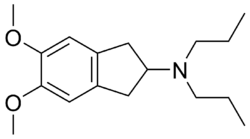Chemistry:PNU-99,194
 | |
| Clinical data | |
|---|---|
| Routes of administration | Oral |
| ATC code |
|
| Legal status | |
| Legal status |
|
| Identifiers | |
| |
| CAS Number |
|
| PubChem CID | |
| ChemSpider | |
| UNII | |
| ChEMBL | |
| Chemical and physical data | |
| Formula | C17H27NO2 |
| Molar mass | 277.408 g·mol−1 |
| 3D model (JSmol) | |
| |
PNU-99,194(A) (or U-99,194(A)) is a drug which acts as a moderately selective D3 receptor antagonist with ~15-30-fold preference for D3 over the D2 subtype.[1][2][3] Though it has substantially greater preference for D3 over D2, the latter receptor does still play some role in its effects, as evidenced by the fact that PNU-99,194 weakly stimulates both prolactin secretion and striatal dopamine synthesis, actions it does not share with the more selective (100-fold) D3 receptor antagonists S-14,297 and GR-103,691.[4]
In rodent studies, low doses of PNU-99,194 produce conditioned place preference (CPP) with no effect on intracranial self-stimulation (ICSS), whereas low doses of D3 agonists like 7-OH-DPAT inhibit ICSS behavior and cause conditioned place aversion (CPA).[5][6][7] In contrast, high doses of PNU-99,194 produce CPA and inhibit ICSS, while high doses of 7-OH-DPAT result in the opposite.[5][6][7] Paralleling this, low doses of PNU-99,194 and 7-OH-DPAT induce hyperactivity and hypoactivity, respectively, whereas the inverse is seen at high doses with both agents.[2][3][7][8][9][10] These data indicate that the D3 receptor has biphasic effects on reward mechanisms and locomotor activity, likely due to opposing roles of autoreceptors versus postsynaptic receptors.[8][11]
Other effects of PNU-99,194 at low doses in rodents include increased nociceptive responses,[12] hypothermia,[4][13] anxiolysis,[14] and facilitation of learning and memory,[12][15][16][17] as well as augmentation and inhibition, respectively, of amphetamine-induced reward and behavioral sensitization,[18][19] and reversal of morphine-induced CPP.[6] At high doses it inhibits the self-administration of cocaine in both rats and monkeys.[1][20]
See also
References
- ↑ 1.0 1.1 "The effects of eticlopride and the selective D3-antagonist PNU 99194-A on food- and cocaine-maintained responding in rhesus monkeys". Pharmacology Biochemistry and Behavior 83 (3): 456–64. March 2006. doi:10.1016/j.pbb.2006.03.007. PMID 16631246.
- ↑ 2.0 2.1 "The dopamine D3-receptor: a postsynaptic receptor inhibitory on rat locomotor activity". Journal of Neural Transmission. General Section 94 (1): 11–9. 1993. doi:10.1007/bf01244979. PMID 8129881.
- ↑ 3.0 3.1 "Effects on locomotor activity after local application of D3 preferring compounds in discrete areas of the rat brain". Journal of Neural Transmission. General Section 102 (3): 209–20. 1995. doi:10.1007/bf01281155. PMID 8788069.
- ↑ 4.0 4.1 "A comparative in vitro and in vivo pharmacological characterization of the novel dopamine D3 receptor antagonists (+)-S 14297, nafadotride, GR 103,691 and U 99194". The Journal of Pharmacology and Experimental Therapeutics 287 (1): 187–97. October 1998. PMID 9765337. http://jpet.aspetjournals.org/cgi/pmidlookup?view=long&pmid=9765337.
- ↑ 5.0 5.1 "Effects of dopamine D3 preferring compounds on conditioned place preference and intracranial self-stimulation in the rat". Journal of Neural Transmission. General Section 101 (1–3): 27–39. 1995. doi:10.1007/bf01271543. PMID 8695055.
- ↑ 6.0 6.1 6.2 "Dopamine D3 receptor ligands modulate the acquisition of morphine-conditioned place preference". Psychopharmacology 175 (2): 127–33. September 2004. doi:10.1007/s00213-004-1807-9. PMID 15095031.
- ↑ 7.0 7.1 7.2 "Dose-dependent effects of the D3-preferring agonist 7-OH-DPAT on motor behaviors and place conditioning". Psychopharmacology 122 (4): 351–7. December 1995. doi:10.1007/BF02246265. PMID 8657832.
- ↑ 8.0 8.1 "The role of dopamine D3 compared with D2 receptors in the control of locomotor activity: a combined behavioural and neurochemical analysis with novel, selective antagonists in rats". Psychopharmacology 174 (3): 341–57. July 2004. doi:10.1007/s00213-003-1770-x. PMID 14985929.
- ↑ "Effects of dopamine D3 receptor antagonists on spontaneous and agonist-reduced motor activity in NMRI mice and Wistar rats: comparative study with nafadotride, U 99194A and SB 277011". Behavioural Pharmacology 15 (4): 253–62. July 2004. doi:10.1097/01.fbp.0000137857.26150.ab. PMID 15252275. https://dx.doi.org/10.1097%2F01.fbp.0000137857.26150.ab.
- ↑ "The dopamine D3 antagonist U-99194A maleate increases social behaviors of isolation-induced aggressive male mice". Psychopharmacology 144 (1): 90–4. May 1999. doi:10.1007/s002130050981. PMID 10379629. http://link.springer.de/link/service/journals/00213/bibs/9144001/91440090.htm. Retrieved 2010-04-30.
- ↑ Meyer ME (October 1996). "Mesolimbic 7-OH-DPAT affects locomotor activities in rats". Pharmacology Biochemistry and Behavior 55 (2): 209–14. doi:10.1016/S0091-3057(96)00066-4. PMID 8951956.
- ↑ 12.0 12.1 "Effects of 7-OH-DPAT and U 99194 on the behavioral response to hot plate test, in rats". Physiology & Behavior 89 (4): 552–62. November 2006. doi:10.1016/j.physbeh.2006.07.014. PMID 16919688.
- ↑ "Dopamine D3 receptor agonists produce similar decreases in body temperature and locomotor activity in D3 knock-out and wild-type mice". Neuropharmacology 38 (4): 555–65. April 1999. doi:10.1016/S0028-3908(98)00213-5. PMID 10221759.
- ↑ "Anxiolytic-like effect of nafadotride and PNU 99194A, dopamine D3 receptor antagonists in animal models". Polish Journal of Pharmacology 52 (6): 459–62. 2000. PMID 11334239.
- ↑ "Dopamine D3 receptor antagonists improve the learning performance in memory-impaired rats". Psychopharmacology 179 (3): 567–75. May 2005. doi:10.1007/s00213-004-2096-z. PMID 15619116.
- ↑ "The effects of selective dopamine agonists on a passive avoidance learning task in the day-old chick". Behavioural Pharmacology 13 (4): 295–301. July 2002. doi:10.1097/00008877-200207000-00006. PMID 12218510. https://dx.doi.org/10.1097%2F00008877-200207000-00006.
- ↑ "Dopamine-mediated disinhibition in the CA1 region of rat hippocampus via D3 receptor activation". The Journal of Pharmacology and Experimental Therapeutics 316 (1): 113–20. January 2006. doi:10.1124/jpet.105.091579. PMID 16162819.
- ↑ "Effects of the D(3) dopamine receptor antagonist, U99194A, on brain stimulation and d-amphetamine reward, motor activity, and c-fos expression in ad libitum fed and food-restricted rats". Psychopharmacology 163 (1): 76–84. August 2002. doi:10.1007/s00213-002-1132-0. PMID 12185403.
- ↑ "D(3) dopamine receptors are down-regulated in amphetamine sensitized rats and their putative antagonists modulate the locomotor sensitization to amphetamine". Brain Research 972 (1–2): 159–67. May 2003. doi:10.1016/S0006-8993(03)02522-8. PMID 12711089.
- ↑ "Targeting the dopamine D3 receptor cannot influence continuous reinforcement cocaine self-administration in rats". Brain Research Bulletin 61 (6): 595–601. October 2003. doi:10.1016/S0361-9230(03)00217-X. PMID 14519456.
 |

